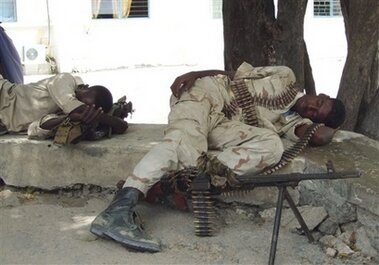The Front Line in Somalia
 By Jeffrey Gettleman (NYTimes) MOGADISHU, Somalia – We duck through a hole in a wall along this city’s blasted-out waterfront, following teenage gunmen with skinny shoulders and enormous guns.
By Jeffrey Gettleman (NYTimes) MOGADISHU, Somalia – We duck through a hole in a wall along this city’s blasted-out waterfront, following teenage gunmen with skinny shoulders and enormous guns.
We creep over old fishing nets that haven’t touched salt water for years. All around us are ruins – ruined buildings, ruined boats, streets pulverized to a fine, bluish-gray rubble. This part of Mogadishu used to be a beautiful seaside promenade, the gem in the Italian colonial crown, a place where tourists gazed out at the Indian Ocean rollers and where Somali fishermen hauled in boatloads of marlin, lobster and tuna. Now, it’s the front line.
“Look,†a Somali soldier yells to me, through a mouth full of rotting teeth. “Dead Shabab.â€
I peek out from behind a stack of sandbags. Sure enough, there’s a body 50 feet away, face down in the street. He must have been killed several weeks ago because his flesh had worn away, showing a white skull.
This is Somalia’s new war. A weak transitional government, backed by the United States, is trying to hold off extremist Islamist insurgents close to Al Qaeda. The leading insurgent group is the Shabab, best known for chopping off arms and stoning adulterers. Most Somalis don’t like them, because their harsh form of Islam is out of sync with Somalia’s more moderate traditions.
But the Shabab don’t seem to care. This war is increasingly spiraling away from Somali control. It’s becoming internationalized, with the Shabab fighting to turn Somalia into a global jihad factory, and the West, led by the United States, determined to prevent that. The Obama Administration recently shipped 40 tons of weapons to the government here and last week, American commandos, in a daring daylight helicopter raid in Somalia, killed a top Al Qaeda agent.
True, Somalia’s been a mess for years. Ever since 1991, when the central government collapsed and clan warlords took over, this sparsely populated, punishingly hot coastal strip has been notorious as one of the most dangerous places in the world.
But the bloodshed is only getting worse as Somalia becomes yet another battleground in the proxy war between the West and militant Islam. The evidence is here, sprawled out in the streets. According to the front line soldiers, the dead Shabab fighter was from Eritrea, a tiny but nettlesome African country widely suspected of funneling arms to Somalia’s insurgents.
The warfare here is shifting too, from fluid, wild street battles to a more settled fight. Sandbags, mortars, even heavy artillery – all that’s part of the mix now, along with suicide bombs and other tricks of Al Qaeda’s trade.
The Shabab are known as die-hard fighters, trained by jihadists from Afghanistan and Pakistan.
“Ten of their guys can defeat 100 of us,†admitted Gen. Mohamed Sheik, chief of the government’s fledgling intelligence services.
But they may be running low on cash. The day I visited the front line, government soldiers pounded the Shabab with heavy machine guns. The Shabab responded with a single assault rifle, sparingly fired, pop by pop.
____
Source: NY Times
Comments
comments
 Calendar
Calendar






































